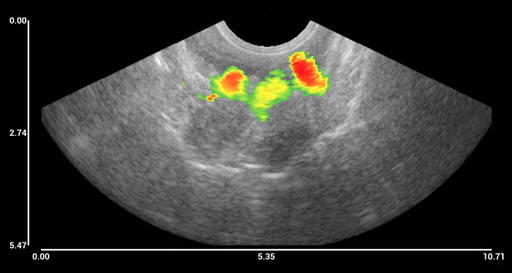An image of magnetic nanoparticles in human tissue generated by magnetomotive ultrasound is shown for the first time. The image created with NanoEcho’s prototype system in the ongoing investigator-led study at Sahlgrenska University Hospital has now been published in a peer-reviewed article (1).
Treatment of rectal cancer patients is largely based on how far the cancer has progressed. Today, this is determined mainly by tissue samples, magnetic resonance imaging and computed tomography. These methods have limitations, which is why NanoEcho has developed a patented imaging system based on the magnetomotive ultrasound method. This system is intended to be used as an aid in the diagnosis of rectal cancer, by demonstrating the difference between diseased and healthy tissue. The method is based on injecting iron oxide-based nanoparticles next to the tumour via the intestine and setting them in motion by an external magnetic field. This movement is captured by ultrasound and imaged on the screen.
“I am pleased to see that we have now made some progress in our efforts to improve rectal cancer diagnostics,” says Eva Angenete, Professor of Surgery at Sahlgrenska University Hospital.
The scientific publication is based on extensive measurements in a laboratory environment, as well as an examination of a patient with rectal cancer undergoing rectal cancer surgery. Prior to surgery, the patient had iron oxide-based nanoparticles injected at three sites near the tumour. The patient then underwent the planned operation, and the part of the rectum where the cancerous tumour was located was removed together with the surrounding lymph nodes, according to standard clinical practice. After the procedure, the surgical removed tissue was examined with the NanoEcho prototype system, and the ultrasound image showed the nanoparticles clearly at all three injection sites.
“It was a great day for us at NanoEcho when we were able to see our system detect nanoparticles in human tissue for the first time ever. It really energised us and motivated us to continue our work. The fact that the results have now been scientifically reviewed and published is, of course, a confirmation of their importance,” says Linda Persson, CEO of NanoEcho.
Image 1. (see image attachment) Magnetomotive ultrasound imaging of iron oxide-based nanoparticles in human tissue. Before surgery, the patient was injected with nanoparticles, and the surgical removed sample was imaged. The three coloured areas correspond to the three injection sites (1).
The article, which is now available online in the journal Nanomedicine: NBM, is the result of a scientific collaboration between Sahlgrenska University Hospital, Lund University and NanoEcho (1).
Link to the article.
(1) Jansson T, Jansson L, Mousavi A, Persson L, Angenete E, Detection of magnetomotive ultrasound signals from human tissue, Nanomedicine: NBM (in press)
For further information, please contact:
Kristina Hallström, CMO & CCO
email: ir@nanoecho.se
NanoEcho is developing a new technique to improve the diagnosis of rectal cancer with further potential applications. Imaging technology relies on a new medical method where nanotechnology is used in combination with modern ultrasound technology. Images produced are intended to facilitate the differentiation between diseased and healthy tissue while favouring a more accurate localisation of cancerous tissue. The goal is to be able to give a precise, simple and cost-effective diagnosis of, among other things, cancers. With clearer diagnostics, the company wants to give treating physicians better guidance for individualised treatment, the intention being that patients’ quality of life after treatment will increase while treatment costs are reduced. www.nanoecho.se

